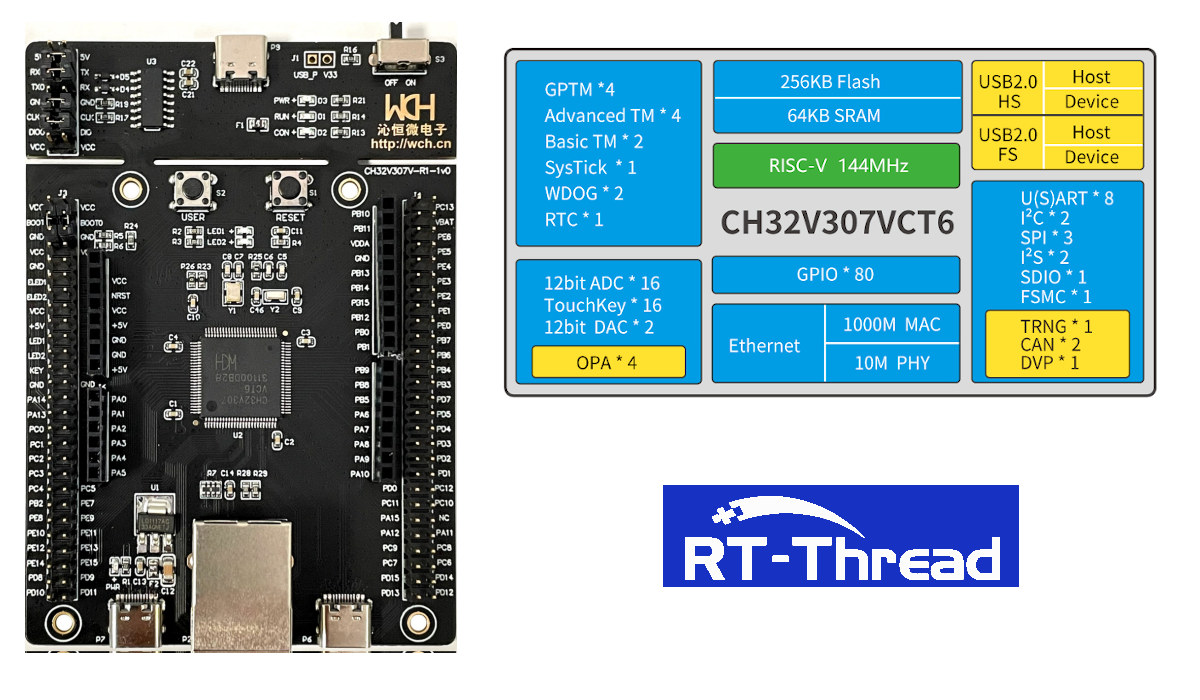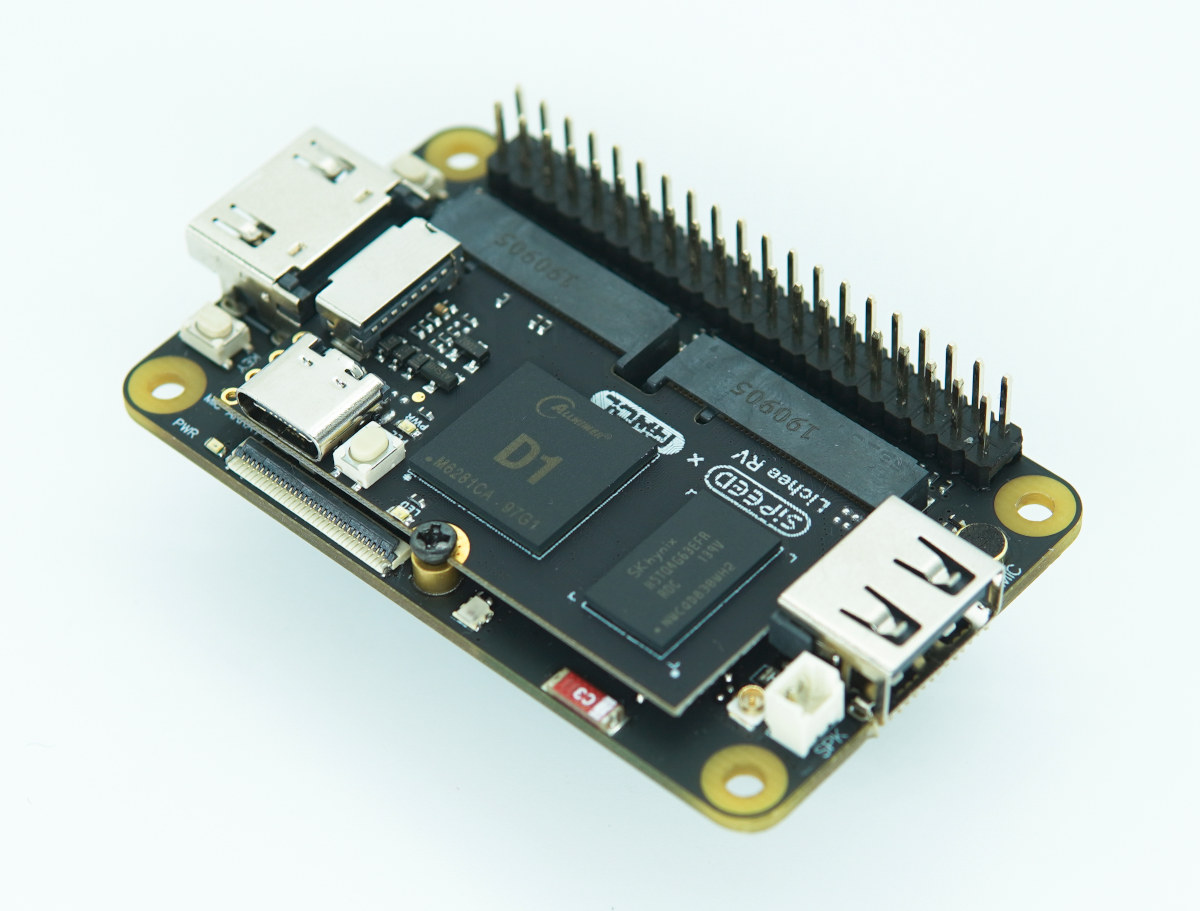Renesas RZ/A3UL is a single-core Cortex-A55 processor clocked at up to 1 GHz designed to run FreeRTOS or Azure RTOS on high-definition (1280×800) HMI solutions requiring quick startup times such as industrial equipment, home appliances, office automation equipment, audio equipment, and POS terminals. The new RZ/A3UL processor family has the same peripheral functions and package pin assignments as the RZ/G2UL (Arm Cortex-A55/M33) and RZ/Five (RISC-V) families targeting Linux-based HMI applications. Renesas also designed a SMARC 2.1 compliant System-on-Module (SoM) based on the Renesas RZ/A3UL microprocessor to speed up time to market. Renesas RS/A3UL specifications: CPU – Single-core Arm Cortex-A55 processor @ up to 1.0 GHz with 32KB I-cache with parity, 32KB D-cache with ECC, 256KB L3 cache with ECC Internal Memory – 128KB SRAM with ECC Memory & Storage I/F 16-bit DDR4-1600 or DDR3L-1333 memory interfaces with in-line ECC; up to 4GB RAM Octal Peripheral Interface (OPI) for flash or […]
RISC-V design challenge – Get a free board, RISC-V chips, and cash prizes
A little while ago, I wrote about WCH CH32V307 32-bit RISC-V MCU that was found in a board with eight UART ports that could be controlled over Ethernet or USB, and the company has released some source code to use the board while inviting the community to submit pull requests to the project. But now WCH, RT-Thread, LCSC, and EasyEDA have joined hands to launch the RISC-V design challenge where the companies will provide a free board or two RISC-V chips to selected participants, as well as cash prizes with up to $1000 offered to the best projects. The companies have prepared 300 boards and 200 chips for this contest. All you need to do to get a chance to get either one CH32V307V-EVT-R1 development board or two CH32V307 RISC-V microcontrollers is to enter your contact and project details in this Google form by April 30, 2022. The conditions are […]
RISC-V or Arm? This tiny 4x4cm Linux board with WiFi offers both options
Last fall, we wrote about Allwinner D1s/F133-A RISC-V processor and the upcoming MangoPi MQ1, a tiny 4x4cm board based on the processor. The board is not for sale, but we have more details, and the company is also working on an Arm version equipped with Allwinner T113-S3 dual-core Cortex-A7 processor that is pin-to-pin compatible with F133-A SoC. The Allwinner F133-A board will finally be called MangoPi Nezha-MQ, or MangoPi MQ for shorts, and come with 64MB on-chip RAM while the Allwinner T113-S3 board, with 128MB on-chip RAM, will be named MangoPi MQ-Dual. Both are fitted with a Realtek RTL8189-based Wi-Fi module, offer display and camera interfaces, two USB-C interfaces, and headers for GPIOs. MangoPi MQ RISC-V or Arm Linux board MangoPi MQ/MQ-Dual specifications: SoC (one or the other) MangoPi MQ – Allwinner D1s/F133-A 64-bit RISC-V processor @ 1 GHz with 64 MB DDR2 MangoPi MQ-Dual – Allwinner T113-S3 32-bit dual-core […]
Allwinner T113-S3 dual-core Cortex-A7 SoC features 128MB DDR3, targets automotive and industrial applications
Allwinner T113-S3 is a dual-core Cortex-A7 processor with 128MB DDR3 on-chip memory that is designed for smart control and HMI applications in the automotive and industrial sectors. At first glance, the new processor looks quite similar to Allwinner S3, but with twice the number of cores. However there’s more to it, as a a HiFi4 DSP has been added for smart audio applications, the H.264 encoder is gone replaced by an MPJEG encoder, and the company claims support for “industrial level working temperature”, plus a 10-year life cycle. among other differences. Allwinner T113-S3 specifications: CPU – Dual-core Arm Cortex-A7 with 32 KB L1 I-cache + 32 KB L1 D-cache per core, and 256 KB L2 cache DSP – Single-core HiFi4 Memory – 128 MB DDR3 Storage I/F – SD3.0/eMMC 5.0, SPI Nor/NAND Flash Video Decoding – H.264, H.265, MPEG-1/2/4, (M)JPEG, VC1 up to 1080p60 Encoding – JPEG/MJPEG up to 1080p60 […]
congatec launches 10 new COM-HPC and COM Express Computer-on-Modules with 12th Gen Intel Core processors (Sponsored)
congatec – a leading vendor of embedded and edge computing technology – introduces the 12th Generation Intel Core mobile and desktop processors (formerly code-named Alder Lake) on 10 new COM-HPC and COM Express Computer-on-Modules. Featuring the latest high-performance cores from Intel, the new modules in COM-HPC Size A and C as well as COM Express Type 6 form factors offer major performance gains and improvements for the world of embedded and edge computing systems. Most impressive is the fact that engineers can now leverage Intel’s innovative performance hybrid architecture. Offering up to 14 cores/20 threads on BGA and 16 cores/24 threads on desktop variants (LGA mounted), the 12th Gen Intel Core processors provide a quantum leap [1] in multitasking and scalability levels. Next-gen IoT and edge applications benefit from up to 6 or 8 (BGA/LGA) optimized Performance-cores (P-cores) plus up to 8 low-power Efficient-cores (E-cores) and DDR5 memory support to […]
Sipeed Lichee RV RISC-V module gets $5+ carrier board with HDMI and USB ports, optional WiFi
Sipeed introduced the Lichee RV Allwinner D1 Linux RISC-V board going for just $17 with 512MB RAM last month. While with a USB-C port it could be used as a standalone part, its dual M.2 connector makes it more like a module and we noted a tiny carrier board was in the works at the time. The baseboard is now available and known as the Lichee RV Dock adding HDMI and USB ports, as well as a 40-pin GPIO header for just $5, or $8 if you’d like to get Wi-Fi 4 and Bluetooth 4.2 connectivity through a Realtek RTL8723DS module. Sipeed Lichee RV Dock specifications: Supported system-on-module (SoM) – Lichee RV module with Allwinner D1 RISC-V processor @ 1 GHz, 512MB DDR3, MicroSD card slot, and USB Type-C OTG port Storage – Optional SPI flash Display interfaces HDMI port up to 4Kp30 Optional RGB interface for up to 720p30 […]
NXP i.MX 93 processor combines Cortex-A55 cores with Ethos U65 microNPU
NXP has unveiled the i.MX 93 processor family comprised of i.MX 935x, 933x, 932x, and 931x parts at this time with up to two Cortex-A55 cores, one Arm Cortex-M33 real-time core, as well as an Ethos U65 microNPU for machine learning (ML). We wrote about i.MX 9 family back in March with NXP telling us it would include an Arm Ethos U-65 microNPU and EdgeLock secure enclave, be manufactured with a 16/12nm FinFET class process, and includes the “Energy Flex” architecture to optimize power consumption by turning on/off specific blocks in the processor. The NXP i.MX 93 is the first family leveraging those new features, and we know have some more details. NXP i.MX 93 processor specifications: CPU 1x or 2x Arm Cortex-A55 @ 1.7 GHz with 32KB I-cache, 32KB D-cache, 64KB L2 cache, 256KB L3 cache with ECC 1x Arm Cortex-M33 @ 250 MHz low power microcontroller with 256KB […]
Status of Zephyr and NuttX RTOS support for ESP32
Espressif has recently announced that both Zephyr and NuttX open-source real-time operating systems had gotten official support for the ESP32 series of WiSoCs. It’s been a long time in the making, and when I first tried the community developer port of Zephyr OS on ESP32 in 2018 it did not work well at all, and I could not even make the blink LED sample work on Wemos Lolin32 board, and the WiFi sample would not even build. But time has passed, Espressif Systems started to officially work on Zephyr in 2020, and now I/Os, WiFi, and some other features work on Zephyr and NuttX RTOSes. Zephyr on ESP32 We first wrote about the Zephyr Project in 2016 describing the OS as follows: Zephyr Project is a lightweight real-time operating system (RTOS) designed for IoT applications and comprised of a microkernel for lower priority tasks, as well as a nanokernel to […]










